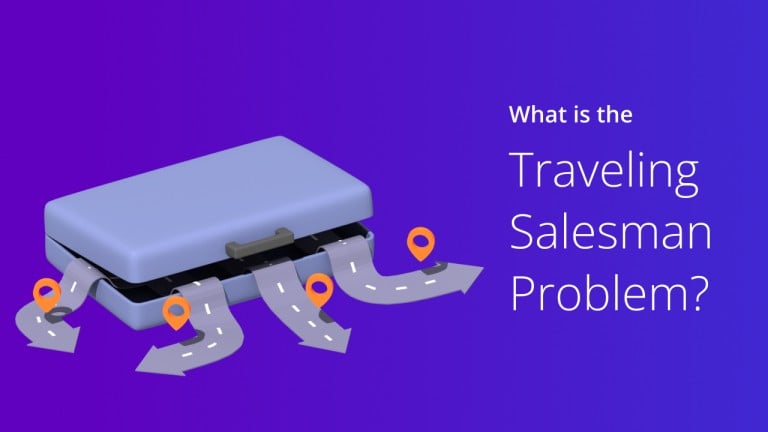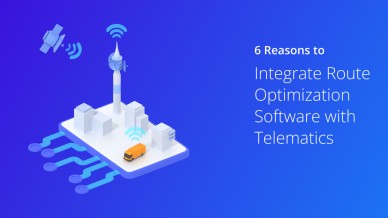The traveling salesman problem is the problem of figuring out the shortest route for field service reps to take, given a list of specific destinations ensuring each location is visited exactly once before returning to the starting point.
Let’s understand the problem with an example.
A salesman wants to visit a few locations to sell goods. He knows the names of the areas and the distances between each one. What is the shortest route the salesman should follow so that he only visits each location once before returning to the starting point?
The TSP is an extension of the Hamiltonian Circuit Problem. It is one of the oldest and most studied combinatorial optimization problems and holds significant implications in complexity theory, including the P versus NP problem.
The vehicle routing problem and traveling purchaser problem are both generalizations of TSP.
Table of Contents
The Background of the Traveling Salesman Problem
The traveling salesman problem (TSP) was formulated in the 1930s and is still extensively studied today. In 1972, Richard Karp proved that the Hamiltonian cycle problem is NP-complete, which led to the understanding that TSP is NP-hard—meaning the complexity of finding the optimal route increases factorially with additional destinations.
For example, there may be three possible routes for four cities, but there could be 360 possible routes for six cities.
This is because the brute-force approach requires evaluating every possible route and then selecting the best one.
This computational effort grows exponentially, making the problem infeasible for large numbers of cities using simple methods.
Despite these challenges, computer scientists have succeeded in calculating optimal solutions for thousands of cities since the early ’90s.
For instance, a large logistics provider could use such solutions to minimize the distance and time taken for deliveries within a state.
Why is the Traveling Salesman Problem Hard?
In theory, TSP can be solved by examining every round-trip route to find the shortest one.
However, as the number of cities increases, the number of possible routes grows rapidly.
For example, with ten cities, there can be over 300,000 round-trip combinations, and with 15 cities, this number exceeds 87 billion.
Early computer scientists hoped someone would develop an improved algorithm to solve TSP efficiently.
While significant progress has been made for specific instances, no universal algorithm can solve every traveling salesman problem case optimally within a reasonable time.
Hence, a one-size-fits-all solution might not be possible.
Applications of the Traveling Salesman Problem
TSP has broad applications across various fields. Solutions derived from TSP are used in:
- Astronomy: To determine the shortest route a telescope should take to observe different stars.
- Internet Planning: To optimize the configuration and data flow in networks.
- Agriculture: For efficiently planning the harvesting sequences.
- Microchip Production: To streamline manufacturing processes.
- Computer-Generated Art: For creating intricate patterns with minimal paths.
Want To See For Yourself How Route4Me Can Boost Your Profits?

Challenges Faced by Traveling Salesmen
Modern salespeople face numerous challenges:
- They often have unpredictable schedules with many confirmed and last-minute appointments.
- Traffic congestion and specific delivery windows add to the complexity.
- Balancing workloads and minimizing routes for a team of sales representatives becomes exponentially challenging.
With 100 customer addresses and eight salespeople, there could be more than a million possible route combinations. Evaluating each manually would take an impractical amount of time.
What is route optimization?
Route optimization is all about finding the most efficient route for a set of stops. Modern algorithms and tools help solve these problems more effectively than traditional methods like pen and paper or simple GPS apps.
ALSO READ: What is Route Optimization?
How to Solve the Traveling Salesman Problem with A Route Planner
As your team grows, manual route planning becomes too complex to manage using pen and paper or standard tools like Google Maps or Waze.
Without some heavy-duty tools like route planning software, you can not manually factor in things like roadblocks and weather conditions. As a result, you will end up spending a lot of time planning routes.
Unforeseen situations such as traffic congestion make it challenging to show up on time.
Balanced workload distribution is difficult if you try to optimize schedules manually.
You also risk increasing your operational costs. Often in the form of wasted fuel and salaries due to longer driving time.
Furthermore, your customers will be annoyed if your sales reps show up late or your drivers fail to make on-time deliveries.
ALSO READ: Why On-Time Delivery Is Important for Your Business
Vehicle routing software is the perfect traveling salesman problem solution.
A route planner powered by sophisticated algorithms like Dijkstra’s Algorithm reduces driving time and fuel consumption by finding near-optimal routes swiftly.
This helps tackle the TSP efficiently, ensuring on-time deliveries, cost savings, and enhanced driver safety.
Learn the six reasons why you need delivery management software.
Frequently Asked Questions (FAQs) about the Traveling Salesman Problem
What is the Traveling Salesman Problem (TSP)?
Why is TSP important in logistics and routing?
Can TSP be solved for large numbers of cities?
What industries benefit from TSP solutions?
How do modern tools solve TSP?
Conclusion about the Traveling Salesman Problem
Many real-world scenarios resemble TSP, with people and vehicles grappling with route optimization challenges.
While perfect solutions are difficult, advancements in complex algorithms and route optimization software have brought us closer to practical and efficient solutions.
The ongoing research and technology continue to improve how we approach and solve optimization issues in various industries.
Want To See For Yourself How Route4Me Can Boost Your Profits?







